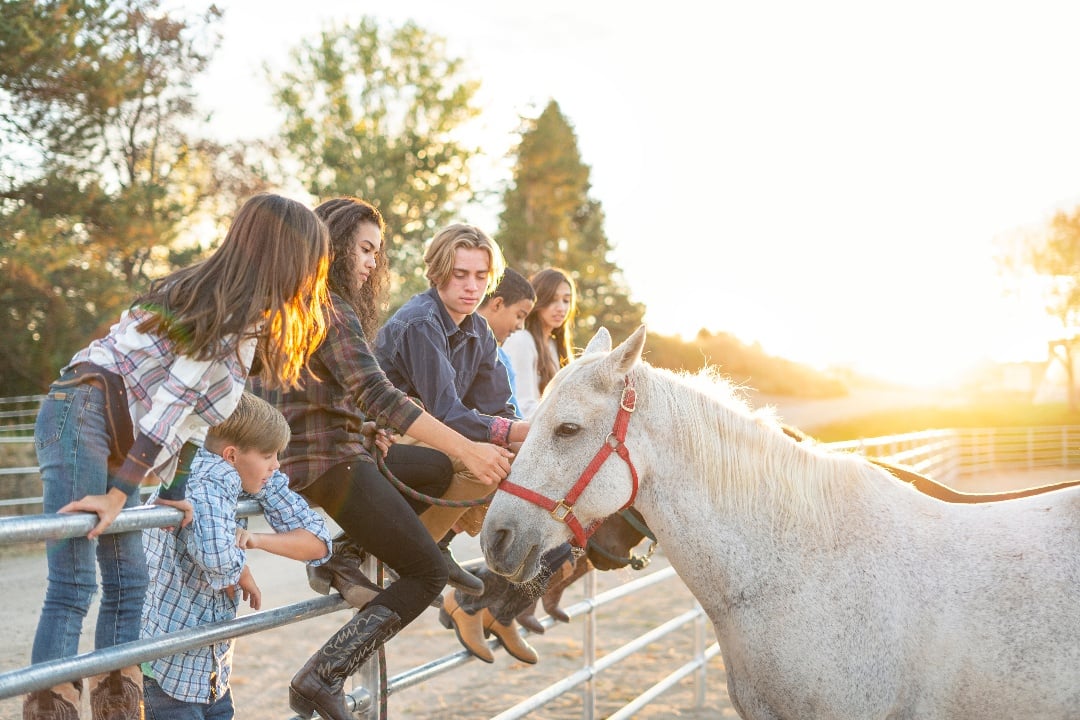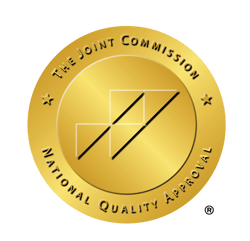Equine Therapy
Working with horses has been a proven method of emotional recovery and one of the unique services offered by Idaho Youth Ranch.

At Idaho Youth Ranch, we’ve seen that healing doesn’t always begin in a traditional therapy room. Sometimes, it starts in an arena—with a horse, a quiet moment, and a new sense of trust.
Our Equine-Assisted Therapy program supports youth and families who may feel stuck, overwhelmed, or disconnected. When communication feels hard, horses help make space for emotional breakthroughs. They mirror emotions, build connection, and guide clients toward healing in a powerful way.
Whether it’s an individual journey or a family experience, these moments with our horses can open doors to healing, understanding, and growth that may not happen anywhere else.
Kids who act out often react from deep pain or anger they don’t understand and can’t explain. Dark memories can be frightening to deal with. And for abused or neglected kids, trusting anyone—especially an adult—is too great of a risk. They’ve learned to protect themselves by shutting out people who try to reach them. It can be tough for a clinician to help a child who can’t or won’t talk about their feelings.
That’s where horses come in. There is an intuitive connection between animals and children. The experience of interacting with a horse—a sympathetic, gentle giant who doesn’t lie, doesn’t judge, sees through pretense, and communicates without words—can be powerfully transformative. At Idaho Youth Ranch, we’ve seen how time spent with horses has helped hundreds of at-risk kids through a special treatment model called Equine Assisted Psychotherapy (EAP).

Equine Assisted Growth and Learning Association (EAGALA) developed Equine Assisted Therapy, the international nonprofit organization that trains and certifies equine therapy professionals worldwide.
In EAP, the horse is considered an integral member of the treatment team, along with an equine specialist (professional horse person) and an equine mental health specialist (a licensed counselor trained and certified in EAP). According to the EAGALA training manual, “EAP is about the horse doing the work of effecting change in people’s lives. It is about the relationship between horse and client.” The therapist’s role is to facilitate that relationship and structure the session to address the issues the client is struggling with.
At Idaho Youth Ranch, Equine Therapy is available to children and families who participate in any of our programs and services, not only kids in residential care. That includes family therapy, group
Idaho Youth Ranch is proud to use the EAGALA Equine Therapy to serve Idaho's most vulnerable youth.
Contact Us Today
Read On For More Information
Table Of Content
- What Is Equine Therapy and What Are the Benefits?
- What Is an Equine Therapy Session Like?
- Understanding the Relationship Between Horses and People
- What Kinds of Issues Can Equine Therapy Treat?
- Types of Equine Assisted Therapy Sessions at Idaho Youth Ranch
- What Are Common Misconceptions About Equine Therapy?
That’s where horses come in. There is an intuitive connection between animals and children. The experience of interacting with a horse—a sympathetic, gentle giant who doesn’t lie, doesn’t judge, sees through pretense, and communicates without words—can be powerfully transformative. At Idaho Youth Ranch, we’ve seen how time spent with horses has helped hundreds of at-risk kids through a special treatment model called Equine Assisted Psychotherapy (EAP).
What Is Equine Therapy and What Are the Benefits?
The Equine Assisted Growth and Learning Association (EAGALA) developed Equine Assisted Therapy, the international nonprofit organization that trains and certifies equine therapy professionals worldwide.
In EAP, the horse is considered an integral member of the treatment team, along with an equine specialist (professional horse person) and an equine mental health specialist (a licensed counselor trained and certified in EAP). According to the EAGALA training manual, “EAP is about the horse doing the work of effecting change in people’s lives. It is about the relationship between horse and client.” The therapist’s role is to facilitate that relationship and structure the session to address the issues the client is struggling with.
At Idaho Youth Ranch, Equine Therapy is available to children and families who participate in any of our programs and services, not only kids in residential care. That includes family therapy, group and individual counseling, short-term crisis relief, and even adoption services. We offer group and individual sessions of Equine Therapy. We also accept Medicaid.
Equine therapy integrates horses into a cohesive and collaborative therapeutic process. In equine therapy at Idaho Youth Ranch, clients interact with horses while being supervised by licensed therapists and equine specialists. Through this process, they learn more about themselves and the world around them.
This treatment can help treat a variety of mental health and behavioral challenges. It can also help support many traditional therapy approaches. Let’s get into what you need to know.
What Is an Equine Therapy Session Like?
What Is an Equine Therapy Session Like?
Unlike horseback riding or horsemanship, equine therapy solely focuses on groundwork. Clients do not ride, groom, or feed the animals. Instead, they interact with them in their habitat and engage with whatever material organically emerges.
Equine therapy sessions tend to last for one hour. Clients meet for their session once per week, and most clients benefit from treatment that lasts 12–15 sessions. Group sessions may last around ten weeks.
Keep in mind that it may take a few sessions for the therapy to truly “click.” At first, it’s normal to feel anxious, uncomfortable, or even bored. This is similar to most therapy methods. That said, most clients start to notice a shift after the third session.
Understanding the Relationship Between Horses and People
Understanding the Relationship Between Horses and People
It’s no secret that many people love horses. They’re majestic, gentle, and incredibly smart. When they trust someone, they tend to be loyal and affectionate. They can also provide companionship and comfort.
By nature, horses are prey animals. That means they depend on their survival instincts to protect themselves. They are also known to be perceptive and intelligent, and because they can detect danger they tend to read human emotions quite well.
Additionally, horses know how to interpret fear. They remember negative situations, and while they can “forgive,” they don’t necessarily forget such danger. Likewise, they intuit body language within each other and within humans.
All of these qualities translate to creating a meaningful relationship with horses. That’s why so many humans gravitate toward these exquisite animals. With horses, they feel safe, protected, and loved.
Today, equine therapy is nationally recognized as a holistic mental health intervention method. Additionally, many facilities and therapists recommend this service for their clients as either a standalone or complementary treatment.
What Kinds of Issues Can Equine Therapy Treat?
What Kinds of Issues Can Equine Therapy Treat?
Clients participate in equine therapy for many reasons. Let’s review some of the top issues this treatment addresses.
Confidence & Self-Esteem
It’s no secret that many children struggle with their self-esteem and self-worth. During this time, “fitting in” is an essential part of human development. If a child feels like they don’t belong, they may feel ashamed and insecure.
Feeling connected to something or someone else can help build confidence. Because horses foster companionship, this dynamic can also foster a sense of meaning within clients.
Impulse Control
Impulse control problems can stem from anxiety, depression, and trauma. Poor impulse control may manifest as aggression, self-harm, bullying, and substance use. Most of the time, the client doesn’t want to engage in the behavior, but they also don’t know how to stop.
Working with horses allows clients to slow down, reflect, and breathe. There’s an inherent need for patience during this therapy, so you can’t rush the horse or the process. This work can model the need for implementing tolerance and acceptance into other parts of life.
Problem-Solving Skills
Critical thinking is an important part of confidence and emotional health. It also helps clients make sound judgments and learn how to trust other people.
Equine therapy allows children and adolescents to understand cause-and-effect, and it can even enhance this skill. For example, they may realize that a certain behavior triggers the horse’s response. Likewise, they may recognize that doing something else can cause a different reaction.
Distress Tolerance
Distress tolerance refers to the ability to sit with uncomfortable emotions. Unfortunately, we live in a society that often encourages people to suppress, numb, or intellectualize how they feel. As a result, most people don’t actually know how to cope with their distress.
Equine therapy doesn’t have an agenda. You aren’t required to “do anything.” For some people, this lack of having a specific task can be unnerving. It may bring their emotions to the center stage, and they will have to learn to sit with them.
Social Awareness
Just like humans, horses are social creatures. They live, eat, bond, and travel together as a herd, and they rely on the resources and support from other animals to feel safe.
Humans also need social skills to succeed in life. We are not meant to brave this journey alone. Participating in equine groups or simply interacting with an animal can enhance the client’s social awareness. They need to think about skills related to boundaries, trust, and assertive communication. All of these skills transcend the equine session to apply to real-life interactions.
Anxiety
Many children struggle with anxiety disorders. Anxiety can disrupt someone’s relationships, confidence, and emotional well-being. These conditions can also make it hard to think rationally, which can perpetuate even more anxiety.
Horses can intuit anxiety. In many ways, horses also mirror human emotions, which means they may respond to or act out the anxiety a client presents. Clients may then use metaphors to describe how they relate to the horse’s experience.
Trauma
When a child undergoes trauma, they may not know how to talk, understand, or process the experience. In some cases, they act out with anger or depression. In other cases, they shut down altogether.
Equine therapy offers a safe and compassionate treatment option for clients struggling with trauma symptoms. Unlike humans, horses hold no outward biases or judgments. A client doesn’t have to worry about “telling their whole story” or being too vulnerable. They can show up as they are.
Depression
Children and adolescents don’t always outwardly express depression in the same ways adults do. They may complain of physical symptoms like headaches or stomachaches, or they might become aggressive toward others or suddenly lose interest in school or favorite activities.
Research on depression shows that pet and animal interaction can have a positive influence on mental health. Equine therapy likely has similar effects. Being in the presence of animals can have therapeutic, calming benefits.
Types of Equine Assisted Therapy Sessions at Idaho Youth Ranch
Types of Equine Assisted Therapy Sessions at Idaho Youth Ranch
Based on the needs your youth is facing, your therapist may recommend individual equine therapy sessions, group equine therapy sessions, or family equine therapy sessions. In some cases your youth’s treatment plan could involve a combination of two or more types of equine therapy sessions.
What Are Common Misconceptions About Equine Therapy?
The mental health field hasn’t researched equine therapy as extensively as some of the more well-known therapy modalities. Therefore, some people don’t fully understand how it works. Let’s unpack some of the common myths.
You Have to Talk About Your Feelings
Equine therapy isn’t a processing therapy. As mentioned, there isn’t an agenda for what you need to do during the session. You don’t have to talk at all if you don’t want to talk.
That said, most people find themselves feeling more comfortable sharing their feelings when they aren’t in a confined space. Because there is no pressure, clients may feel more open and relaxed. The horse can provide a welcoming discussion topic to start talking about their needs.
You Can Play With or Ride the Horses
As mentioned, equine therapy consists of groundwork. While horseback riding and horsemanship can provide emotional benefits, this therapy doesn’t employ either of those things.
Instead, equine therapy focuses on the interaction between the horse and the client. You can observe, interact, and safely engage with the horse. You can also talk about what you see the horse doing or how you imagine the horse might be feeling.
You Can Engage in Equine Therapy If You Like Horses
Equine therapy isn’t just about liking horses. In fact, some people feel nervous about working with animals before they begin the process.
Additionally, equine therapy needs to be clinically appropriate for your treatment. It’s not recommended or suitable for everyone. If equine work interests you, talk with your therapist or counselor.
Equine Therapy Isn’t Real Therapy
Therapy itself isn’t a regulated definition. Instead, therapy is somewhat of an umbrella term referring to interventions designed to improve mental health.
Experiential therapy has gained traction in recent years for providing alternative support for clients struggling with their life circumstances. These treatments can be extremely beneficial in helping clients cope with their distress.
Equine Therapy Requires That You Understand Horses
Many clients who engage in this treatment have no previous experience with horses. It doesn’t matter how much knowledge or background you have with these animals.
The facilitators will teach you what you need to know about how to interact with the animals. Your job is to simply show up and be open to the process of learning and growth.
Equine Therapy Is Just About Hanging Out with Horses
Although your sessions may not seem as structured as some other therapies, your therapist will create a treatment plan for your care. Your treatment plan includes various goals, objectives, and potential barriers to your progress. This plan is vital for measuring your outcomes and treatment success.
Equine therapy can offer a profound healing experience for individuals, families, and groups. It’s a unique experience that can benefit many people struggling with a variety of issues.
There is an intuitive and sacred connection shared between animals and people. This connection differs between that of a client and a therapist in a traditional setting.
Working with a kind and gentle giant allows children to tap into parts of themselves they may otherwise ignore or disregard.
At Idaho Youth Ranch, we are proud to offer this unique therapy option to our clients. Contact us today to learn more about how we can help you or your child.

Idaho Youth Ranch has earned The Joint Commission’s Gold Seal of Approval® for its outpatient counseling & therapy centers – including equine therapy, Hays House youth shelter, and adoptions program.
Accreditation by demonstrating continuous compliance with its performance standards. The Gold Seal is a symbol of quality that reflects a health care organization’s commitment to providing safe and quality patient care.
